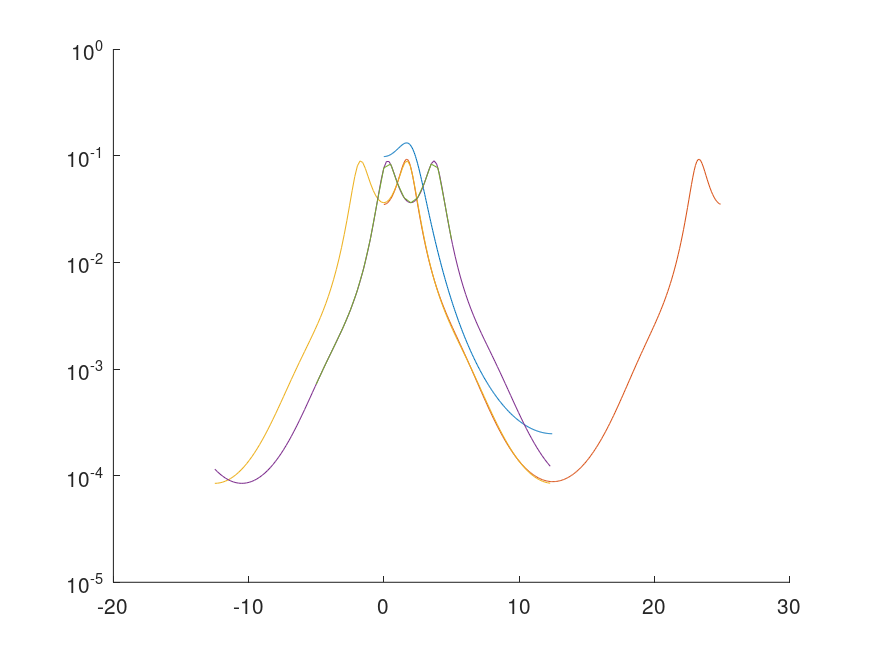- Function File:
[psd,f_out] =pburg(x,poles, freq, Fs, range, method, plot_type, criterion)¶ Calculate Burg maximum-entropy power spectral density.
The functions "arburg" and "ar_psd" do all the work. See "help arburg" and "help ar_psd" for further details.
ARGUMENTS:
All but the first two arguments are optional and may be empty.
- x
[vector] sampled data
- poles
[integer scalar] required number of poles of the AR model
- freq
[real vector] frequencies at which power spectral density is calculated.
[integer scalar] number of uniformly distributed frequency values at which spectral density is calculated. [default=256]
- Fs
[real scalar] sampling frequency (Hertz) [default=1]
CONTROL-STRING ARGUMENTS – each of these arguments is a character string.
Control-string arguments can be in any order after the other arguments.
- range
’half’, ’onesided’ : frequency range of the spectrum is from zero up to but not including sample_f/2. Power from negative frequencies is added to the positive side of the spectrum.
’whole’, ’twosided’ : frequency range of the spectrum is -sample_f/2 to sample_f/2, with negative frequencies stored in "wrap around" order after the positive frequencies; e.g. frequencies for a 10-point ’twosided’ spectrum are 0 0.1 0.2 0.3 0.4 0.5 -0.4 -0.3 -0.2 -0.1
’shift’, ’centerdc’ : same as ’whole’ but with the first half of the spectrum swapped with second half to put the zero-frequency value in the middle. (See "help fftshift". If "freq" is vector, ’shift’ is ignored. If model coefficients "ar_coeffs" are real, the default range is ’half’, otherwise default range is ’whole’.
- method
’fft’: use FFT to calculate power spectral density.
’poly’: calculate spectral density as a polynomial of 1/z N.B. this argument is ignored if the "freq" argument is a vector. The default is ’poly’ unless the "freq" argument is an integer power of 2.
- plot_type
’plot’, ’semilogx’, ’semilogy’, ’loglog’, ’squared’ or ’db’: specifies the type of plot. The default is ’plot’, which means linear-linear axes. ’squared’ is the same as ’plot’. ’dB’ plots "10*log10(psd)". This argument is ignored and a spectrum is not plotted if the caller requires a returned value.
- criterion
[optional string arg] model-selection criterion. Limits the number of poles so that spurious poles are not added when the whitened data has no more information in it (see Kay & Marple, 1981). Recognized values are
’AKICc’ – approximate corrected Kullback information criterion (recommended),
’KIC’ – Kullback information criterion
’AICc’ – corrected Akaike information criterion
’AIC’ – Akaike information criterion
’FPE’ – final prediction error" criterion
The default is to NOT use a model-selection criterion
RETURNED VALUES:
If return values are not required by the caller, the spectrum is plotted and nothing is returned.
- psd
[real vector] power-spectral density estimate
- f_out
[real vector] frequency values
HINTS
This function is a wrapper for arburg and ar_psd.
See "help arburg", "help ar_psd".
Demonstration 1
The following code
a = [1.0 -1.6216505 1.1102795 -0.4621741 0.2075552 -0.018756746]; Fs = 25; n = 16384; signal = detrend (filter (0.70181, a, rand (1, n))); % frequency shift by modulating with exp(j.omega.t) skewed = signal .* exp (2*pi*i*2/Fs*[1:n]); hold on; pburg (signal, 3, [], Fs); pburg (signal, 4, [], Fs, "whole"); pburg (signal, 5, 128, Fs, "shift", "semilogy"); pburg (skewed, 7, 128, Fs, "AKICc", "shift", "semilogy"); user_freq = [-0.2:0.02:0.2]*Fs; pburg (skewed, 7, user_freq, Fs, "AKICc", "semilogy"); hold off;
Produces the following figure
| Figure 1 |
|---|
 |
Package: signal